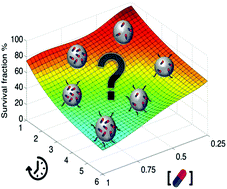Our official English website, www.x-mol.net, welcomes your feedback! (Note: you will need to create a separate account there.)
An experimental and computational framework for engineering multifunctional nanoparticles: designing selective anticancer therapies
Nanoscale ( IF 6.7 ) Pub Date : 2017-09-01 00:00:00 , DOI: 10.1039/c7nr04475e A. Aires 1, 2, 3, 4, 5 , J. F. Cadenas 3, 4, 5, 6, 7 , R. Guantes 5, 8, 9, 10, 11 , A. L. Cortajarena 1, 2, 3, 4, 5
Nanoscale ( IF 6.7 ) Pub Date : 2017-09-01 00:00:00 , DOI: 10.1039/c7nr04475e A. Aires 1, 2, 3, 4, 5 , J. F. Cadenas 3, 4, 5, 6, 7 , R. Guantes 5, 8, 9, 10, 11 , A. L. Cortajarena 1, 2, 3, 4, 5
Affiliation

|
A key challenge in the treatment of cancer with nanomedicine is to engineer and select nanoparticle formulations that lead to the desired selectivity between tumorigenic and non-tumorigenic cells. To this aim, novel designed nanomaterials, deep biochemical understanding of the mechanisms of interaction between nanomaterials and cells, and computational models are emerging as very useful tools to guide the design of efficient and selective nanotherapies. This works shows, using a combination of detailed experimental approaches and simulations, that the specific targeting of cancer cells in comparison to non-tumorigenic cells can be achieved through the custom design of multivalent nanoparticles. A theoretical model that provides simple yet quantitative predictions to tune the nanoparticles targeting and cytotoxic properties by their degree of functionalization is developed. As a case study, a system that included a targeting agent and a drug and is amenable to controlled experimental manipulation and theoretical analysis is used. This study shows how at defined functionalization levels multivalent nanoparticles can selectively kill tumor cells, while barely affecting non-tumorigenic cells. This work opens a way to the rational design of multifunctionalized nanoparticles with defined targeting and cytotoxic properties for practical applications.
中文翻译:

工程多功能纳米粒子的实验和计算框架:设计选择性抗癌疗法
用纳米药物治疗癌症的关键挑战是工程化和选择导致在致瘤细胞和非致瘤细胞之间具有所需选择性的纳米颗粒制剂。为此,新颖的纳米材料设计,对纳米材料与细胞之间相互作用机理的深入生化理解以及计算模型正在成为指导有效和选择性纳米疗法设计的非常有用的工具。这项工作表明,结合详细的实验方法和模拟,与非致瘤细胞相比,癌细胞的特异性靶向可以通过多价纳米粒子的定制设计来实现。开发了一种理论模型,该模型提供了简单而定量的预测,以通过其功能化程度来调整纳米粒子的靶向性和细胞毒性。作为案例研究,使用了包含靶向剂和药物并适合于受控实验操作和理论分析的系统。这项研究表明,在限定的功能化水平下,多价纳米粒子可以选择性杀死肿瘤细胞,而几乎不影响非致瘤细胞。这项工作为合理设计具有定义的靶向和细胞毒性特性的多功能纳米颗粒,为实际应用开辟了道路。这项研究表明,在限定的功能化水平下,多价纳米粒子可以选择性杀死肿瘤细胞,而几乎不影响非致瘤细胞。这项工作为合理设计具有定义的靶向和细胞毒性特性的多功能纳米颗粒提供了一种实用方法。这项研究表明,在限定的功能化水平下,多价纳米粒子可以选择性杀死肿瘤细胞,而几乎不影响非致瘤细胞。这项工作为合理设计具有定义的靶向和细胞毒性特性的多功能纳米颗粒,为实际应用开辟了道路。
更新日期:2017-09-21
中文翻译:

工程多功能纳米粒子的实验和计算框架:设计选择性抗癌疗法
用纳米药物治疗癌症的关键挑战是工程化和选择导致在致瘤细胞和非致瘤细胞之间具有所需选择性的纳米颗粒制剂。为此,新颖的纳米材料设计,对纳米材料与细胞之间相互作用机理的深入生化理解以及计算模型正在成为指导有效和选择性纳米疗法设计的非常有用的工具。这项工作表明,结合详细的实验方法和模拟,与非致瘤细胞相比,癌细胞的特异性靶向可以通过多价纳米粒子的定制设计来实现。开发了一种理论模型,该模型提供了简单而定量的预测,以通过其功能化程度来调整纳米粒子的靶向性和细胞毒性。作为案例研究,使用了包含靶向剂和药物并适合于受控实验操作和理论分析的系统。这项研究表明,在限定的功能化水平下,多价纳米粒子可以选择性杀死肿瘤细胞,而几乎不影响非致瘤细胞。这项工作为合理设计具有定义的靶向和细胞毒性特性的多功能纳米颗粒,为实际应用开辟了道路。这项研究表明,在限定的功能化水平下,多价纳米粒子可以选择性杀死肿瘤细胞,而几乎不影响非致瘤细胞。这项工作为合理设计具有定义的靶向和细胞毒性特性的多功能纳米颗粒提供了一种实用方法。这项研究表明,在限定的功能化水平下,多价纳米粒子可以选择性杀死肿瘤细胞,而几乎不影响非致瘤细胞。这项工作为合理设计具有定义的靶向和细胞毒性特性的多功能纳米颗粒,为实际应用开辟了道路。



























 京公网安备 11010802027423号
京公网安备 11010802027423号